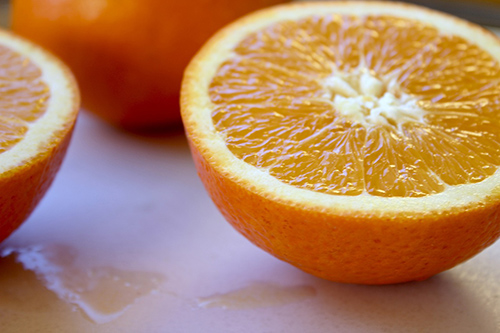Contents
“It is completely absurd that in this region, vitamin C supplements and the benefits of oranges need a recommendation by physicians,” declared Professor Stepp in his seminal lecture at the School of Medicine in Valencia (Spain).
During the 1940s, the pharmaceutical industry was proud of its ability to synthesize most vitamins. Professor Stepp, a distinguished German scientist world-known for his vitamin studies, was attending a scientific conference in the Mediterranean city of Valencia.

Some local colleagues took him to visit the beautiful orange groves in the Valencia countryside, where he had the privilege of eating some of the world’s best tree-ripened fruit. It was then that this German man of science and the advocate of synthetic vitamins forgot his science and exclaimed:
“How much more healthful it is to enjoy a good Valencian orange than to take the best vitamin C supplement that our industry has to offer!”
Professor Stepp was correct: A natural orange is superior to any pharmaceutical preparation as a vitamin C source. We now know that besides vitamin C, this fruit contains about 170 phytochemicals that potentiate and complement the benefits of oranges in the body.
All of these, together with the sense of well-being, even pleasure, that one gains from eating an orange – pleasure is also a health factor, causing its health effects to be much more significant than expected from its 50 mg/100 g of vitamin C. Despite what promoters of pharmaceutical chemistry may claim, the 50 mg/100 g of vitamin C in oranges provides much more to the body than 50 mg or 500 of any pill or medication.
How to Use and Prepare Oranges

- Orange benefits (Fresh): When eating this fruit, the white inner orange peel should be included, as well as the pulp fibers if it is not tough.
- Benefits of orange juice: Ideally, the juice should be drunk fresh-squeezed since vitamin C loses its potency over time and exposure to light. Canned orange juice loses some of its natural vitamin C, although some bottlers enrich it with synthetic vitamin C.
- Orange treatment: This treatment should be followed one or two days per week for three or four weeks. It consists of eating only oranges each day and drinking only fresh juice. Ten to twelve oranges may be eaten, and 2 to 4 glasses of juice may be drunk daily. Two teaspoons of honey may be added to each glass if the oranges are bitter.
Scientific Facts
- Related species: Citrus aurantium L. (bitter orange)
- French: Orange.
- Spanish: Naranja.
- German: Orange.
- Description: Aggregate fruit of the orange tree (‘Citrus Sinensis’ Osbeck), an evergreen tree of the botanical family Rutaceae. Like all citrus, the orange is composed of various fruits joined to form a simple fruit.
- Habitat: Originally from China, oranges are cultivated in all the hot areas of the world in the so-called “citrus belt,” between 40 degrees north latitude and 35 degrees south latitude.
Orange Nutritional Facts
In moderate amounts, sugars are easily assimilated by the body and tolerated by people with diabetes. The sugars are saccharose, dextrose, and levulose.
Minerals, among which potassium and calcium stand out. Oranges also comprise smaller but substantial amounts of iron and magnesium.

Vitamins, besides vitamin C, oranges, contain carotenoids responsible for their typical color, vitamin B1 and vitamin B2.
Folic acid, this essential nutrient, is vital for properly developing the fetal nervous system. It also acts as an antioxidant whose blood presence is necessary for the defensive cells’ proper function, such as leukocytes or white blood cells.
Vegetable fiber, in the form of pectin, which fights cholesterol. Fiber is the only component of the orange that is not present in orange juice; however, it plays a vital role in the many benefits of oranges.
Organic acids, mainly citric acid, potentiate vitamin C activity and enable the purging of toxic deposits such as uric acid from the body.
Carotenoids are substances similar to beta-carotene, which also transform into vitamin A in the body. They act as powerful antioxidants. Of the twenty carotenoids found in the orange, the most prominent are beta-cryptoxanthin, lutein, and zeaxanthin.
Phytochemicals are substances found in minimal amounts in foods but play significant roles within the body. There are about one hundred and seventy different phytochemicals in the orange, and it is still possible to discover more. From a chemical viewpoint, there are two main groups of phytochemicals responsible for the benefits of oranges, such as:

- Flavonoids: These are potent antioxidants, anti-inflammatory, and anticarcinogenic glucosides. They also have a positive effect on the circulatory system. The best-known are rutin, tangeretin, nobiletin, naringin, hesperidin, and quercetin.
- Limonoids are responsible for the orange’s aroma, which forms part of its essence. Chemically, these are terpenes, the most abundant of which is d-limonene. This substance in oranges prevents tumor formation in experimental animals after being introduced to known carcinogens.
An essential property of the phytochemicals abundant in oranges and citrus fruits is that they potentiate the effect of specific vitamins such as vitamin C. Today, science is beginning to understand a fact that a select few knew for decades: vitamins are much more effective if taken from natural sources that include whole food; this ensures you get the complete and comprehensive benefits of oranges.
Benefits of Oranges
Thanks to its extraordinary chemical composition, the orange increases disease resistance, protects the arteries, and is antiallergenic, alkalizing, remineralizing, and anti-carcinogenic. Thanks to its dietetic and therapeutic properties, here are some of the many health benefits of oranges:
Infectious diseases
Oranges should always be part of the diet of anyone with a communicable disease or individuals who wish to prevent them. Studies show that at least four oranges daily (250 milligrams of vitamin C) are required to attain results. It is crucial to note that vitamin C or consuming oranges cannot inhibit flu or colds. However, they have been shown to reduce the duration of the disease and lessen the seriousness of symptoms.
Oranges have subsequent impacts on infections, thanks to the mixture of vitamin C and the additional natural chemical elements they comprise:
- They boost the disease-fighting abilities of the white blood cells.
- They improve the number and durability of white blood cells. This is ascribed to the collective effect of vitamin C and folic acid.
- They slow but do not completely halt the development of viruses within human cells. The orange flavonoids and vitamin C are accountable for this action.
- They improve the creation of interferon, an antiviral protein generated within the body itself.
Thus, eating oranges daily is indicated for not only colds and flu but for any infectious disease, including those associated with childhood and even AIDS.
Thrombosis, Arteriosclerosis, and Cardiovascular Disease
The flavonoids in oranges, potentiated by vitamin C, inhibit the buildup of clot-forming platelets in the blood. Thus, oranges help make the blood more fluid and improve circulation, particularly in the two organs requiring the most consistent blood supply: the brain and the heart. Oranges also contain four highly effective antioxidants that manually potentiate themselves: vitamin C, quercetin (a flavonoid-type phytochemical), provitamin A, and folic acid.
The result is a powerful antioxidant effect on all body cells. It is known that arteriosclerosis and the aging process have their biochemical origin in oxidizing phenomena. High doses of vitamin C (one gram daily for six weeks) reduce blood pressure. The PULP of the orange, including the white inner peel or mesocarp, is rich in pectin, a type of soluble fiber that decreases cholesterol levels.

Regular orange consumption, including the pulp and mesocarp (the white inner peel), is associated with reduced blood cholesterol, lowered blood pressure, and lower risk of arteriosclerosis, arterial thrombosis, and heart disease.
Constipation
Oranges help cure constipation and intestinal atony through two mechanisms:
- They stimulate the emptying of the gallbladder (cholagogic effect), with the subsequent laxative effect of bile in the intestine.
- Their soft vegetable fiber stimulates peristaltic action in the intestine.
In addition to relieving constipation, oranges alleviate the hemorrhoids that often accompany it. An orange treatment should be followed to achieve the best results.
Allergies
Persons with elevated levels of vitamin C in the blood suffer less from allergies. This is probably because vitamin C is partially agonistic to the effects of histamine, which initiates allergic episodes. Eating four or five oranges a day (or their equal in juice) contributes to preventing the appearance of allergic reactions such as rhinitis or bronchial asthma.
Demineralization
With 30 to 40 mg/100 grams of calcium, oranges are the richest citrus fruit in this valuable mineral (milk contains 119 mg). Additionally, oranges’ citric acid improves calcium absorption in the intestine. Oranges also contain magnesium and phosphorus.
Vitamin C is essential in the growth and maintenance of bones, teeth, and cartilage. Oranges are recommended in cases of osteoporosis and rickets and whenever an increased supply of mineral salts is required.
Excess Uric Acid (Gout)
A treatment with oranges (as with lemons, is very effective in dissolving and eliminating the uric acid deposits within the joints that cause uratic arthritis; kidney stones may also be at least partially dissolved with an orange treatment. All this is because of the alkalizing effect of oranges and all citrus fruits. Although it seems a paradox, oranges are excellent blood alkalizing despite their acid taste.
Eye conditions
Because of their richness in carotenoids and other antioxidants, oranges help prevent macular degeneration of the retina, the principal cause of blindness in individuals over 65 in Western countries.
Cancer prevention
Vitamin C is anticarcinogenic, like the phytochemicals in oranges and other citrus fruits. Numerous studies have proven that eating at least one orange or other citrus fruit prevents cancer. Patients already diagnosed with this disease can also benefit from abundant orange consumption.
Citrus Helps Prevent Cancer
All fruits possess anticarcinogenic properties, and eating fruit regularly prevents cancer. However, citrus fruits are remarkable for their balanced combination of anticarcinogenic substances: vitamin C, flavonoids, limonoids, and pectin. All of these substances potentiate one another to achieve a striking prophylactic effect. This means that each one taken in isolation and purified is not as effective as when consumed as part of an orange or a lemon, for example.
The anticarcinogenic effects of these citrus components have been confirmed using laboratory animals, reaffirming the validity of numerous statistical studies that relate citrus consumption to lowered risk.
Vitamin C – This potent antioxidant and antitoxin can neutralize various carcinogens, such as the nitrosamines that form in cured meat and sausages. Vitamin C also enhances the function of the immune system and helps slow the spread of tumor cells.
Flavonoids – These are non-nutritive components of foods, also called phytochemicals, found in most fruits. When they were discovered, they were thought to be simple vegetable pigments whose only function was to give color to the fruit. Today, it is well known that they have great healing and preventative power, acting as antioxidants, anti-inflammatories, and anticarcinogens. “In vitro” experiments have demonstrated that the flavonoids in citrus can halt the development of malignant tumors and prevent metastasis.
Limonoids – These are among the many aromatic substances found in citrus. They are located primarily in the peel. The best known is d-limonene. Animal studies have demonstrated that it can neutralize carcinogens that cause stomach and breast cancer. In this way, d-limonene prevents this disease.
Pectin – This soluble fiber is found in the pulp and white inner peel. Pectin also forms part of other fruits, such as the apple. A study at the University of Detroit demonstrated that citrus pectin prevents prostate cancer metastasis in laboratory rats. It likely has a similar effect on human beings, not only prostate cancer but other types of cancer.
Anatomy of an Orange
- Exocarp (peel) – Orange peel contains a very aromatic essential oil rich in flavonoids. Orange peel extract protects the vascular system, improves appetite, and calms the nerves.
- Mesocarp (white inner peel) – This part of the fruit is rich in pectin, a vegetable fiber known for its anti-cholesterol and anticarcinogenic properties. Its medical application has gained importance since a study by the National Cancer Institute of the United States demonstrated that it is a potent inhibitor of prostate cancer in laboratory rats.
The orange’s mesocarp may be eaten without difficulty. Considering the benefits of cholesterol and possibly cancer, one should not discard the white material that adheres to the pulp when the fruit is peeled. - Endocarp (juicy pulp) – This is the most edible portion of the fruit, composed of eight to twelve sections consisting of tiny cells filled with juice. Once the juice has been extracted, the orange pulp is rich in pectin and other vegetable fiber. It is a good practice to eat the pulp if it is not too fibrous.
Green Oranges can be Ripe
Developing their typical orange color requires several consecutive cold nights while still on the tree. This is common in temperate countries. However, in tropical countries, it is expected to find green ripe oranges because they have not been exposed to the cold.
The point of ripeness of an orange is not judged by its exterior color but by the proportion of sugar and acid in its juice. In mature fruits, this proportion is approximately 6:1; in other words, six times more sugar than acid.
Citrus to Eat and Drink
All sour or citrus fruits share their sweet and sour flavor and refreshing juices, which are available for most of the year. All citrus fruits’ dietetic and therapeutic properties are very similar due to a balanced combination of vitamin C, minerals, and phytochemicals.
Lime – The lime is similar in color, size, and shape to the lemon, but its flavor is less sour and much sweeter. It is grown primarily in Central America, Florida, and California. Its vitamin C and B content are somewhat inferior. It is used for beverages because of its pleasant aroma.
Lemon – Possibly the citrus, the most scientifically proven medicinal application.
Tangerine – This is the sweetest and mildest-flavored citrus.

Bitter oranges – These are not edible raw because of their intense flavor. They are only used in confectionery and jellies. The bitter orange is the most used for phytotherapeutic purposes since its leaves, blossoms, and peel contain high concentrations of essences and other active substances.
Orange – This is the most widely cultivated and valued citrus.
Kumquat – These are grown primarily in Indonesia, Australia, and Florida. Their size varies between two and three cm in diameter. Kumquats are eaten with the skin, which is soft and slightly acidic. It is an aromatic and pleasant fruit.
Grapefruit – Grapefruits are effective against arteriosclerosis. They are used in weight loss diets because of their detoxifying properties.
Calamondin – This citrus is grown in tropical countries. It is orange in color and measures about 2.5 cm in diameter. It is very juicy with a slightly bitter taste. It is used to make beverages and jellies.
Citron – This was the first introduced in Europe, brought from Asia by Alexander the Great in 300 B.C. Its fruits are large, weighing as much as two kilos. The peel is typically yellow, very thick, and wrinkled. Although it contains less vitamin C than other citrus, its calcium content is higher. Its culinary use is minimal, primarily to provide aroma to pastries such as the famous plum cake.

Benefits of Orange Juice
Orange juice is an extremely popular drink that people worldwide enjoy at breakfast. This juice is almost the same as eating fruit without calcium and fiber. You can find the calcium and fiber mainly in the pulp.
Juices made from reconstituted juice are an excellent alternative to natural juice. The vitamin C lost in processing is calculated at about 10%. Bottled juice maintains the remaining vitamins, folic acid, and minerals well. In any case, bottled or frozen juice is better than nothing in the absence of fresh juice.
Four oranges daily are recommended for those wanting to strengthen their immune system and take full advantage of the many benefits of oranges.
Comparison Between the Composition of 100 g of Orange and its Juice
| Nutrient | Orange | Fresh Juice |
| Vitamin A (ug RE) | 21 | 20 |
| Vitamin B1 (mg) | 0.087 | 0.09 |
| Vitamin C (mg) | 53.2 | 50 |
| Folates (ug) | 30.3 | 30.3 |
| Calcium (mg) | 40 | 11 |
| Magnesium (mg) | 10 | 11 |
| Iron (mg) | 0.1 | 0.2 |
| Fiber (g) | 2.4 | 0.2 |
DISCLAIMER: All content on this website is presented solely for educational and informational objectives. You should not rely on the information provided as a replacement for advice, diagnosis, or treatment from a qualified medical expert. If you are pregnant, nursing, or have any preexisting medical concerns, you should talk to your doctor before using any herbal or natural medicines.
REFERENCES
- George D. Pamplona-Roger, M.D. “Encyclopedia of Foods and Their Healing Power.” George D. Pamplona-Roger, M.D. Encyclopedia of Foods and Their Healing Power. Trans. Annette Melgosa. Vol. 2. Chai Wan: Editorial Safeliz, 2005. 360,361,362,363,364,365. Print. [benefits of oranges]
- National Institutes of Health (NIH): https://ods.od.nih.gov/factsheets/VitaminC-HealthProfessional/
